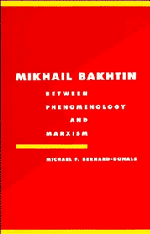Book contents
- Frontmatter
- Contents
- Preface
- Acknowledgments
- Abbreviations
- 1 Problems with Formalism
- 2 Neo-Kantianism and Bakhtin's phenomenology
- 3 Reception and hermeneutics: the search for ideology
- 4 The Marxist texts
- 5 Science and ideology
- 6 Science, praxis, and change
- 7 Bakhtin, the problem of knowledge, and literary studies
- Bibliography
- Index
3 - Reception and hermeneutics: the search for ideology
Published online by Cambridge University Press: 03 May 2011
- Frontmatter
- Contents
- Preface
- Acknowledgments
- Abbreviations
- 1 Problems with Formalism
- 2 Neo-Kantianism and Bakhtin's phenomenology
- 3 Reception and hermeneutics: the search for ideology
- 4 The Marxist texts
- 5 Science and ideology
- 6 Science, praxis, and change
- 7 Bakhtin, the problem of knowledge, and literary studies
- Bibliography
- Index
Summary
Two representatives of contemporary phenomenological aesthetic theory that have found widespread use in American departments of English are Wolfgang Iser's “phenomenology of reading” and Hans Robert Jauss's Rezeptionsaesthetik. Both theories were developed in the 1960s and early 1970s in reaction to Husserlian phenomenological theory (or, more specifically, to the work of Roman Ingarden and Hans-Georg Gadamer, two of Husserl's followers). Ingarden worked most closely with Husserl's philosophy, and as a result his theory pays closest attention to the way in which individual human subjects come to cognition of aesthetic objects, and pays a great deal less attention to the ways in which those subjects are situated historically or socially. Iser's work, in The act of reading and The implied reader, shows a similar de-emphasis on the role of social history in the act of reading or interpreting a text. While the role of language in the construction of intersubjective relations is the key to Ingarden's and (even more so) Iser's work, neither carries this notion to its logical endpoint, that is to see how the various complex intersubjective human relations might be seen to form a larger social construct.
Gadamer's work also takes as its point of departure Husserl's larger phenomenological project, but goes beyond it by suggesting that Husserl's transcendental ego was inadequate to a theory of linguistically mediated understanding or of cultural interpretation generally. He incorporates into Husserl's work the idea that individual human subjects come into a unique relationship with an aesthetic artefact, and notes that the relationship is of a different order from ordinary experience.
- Type
- Chapter
- Information
- Mikhail BakhtinBetween Phenomenology and Marxism, pp. 47 - 86Publisher: Cambridge University PressPrint publication year: 1995

